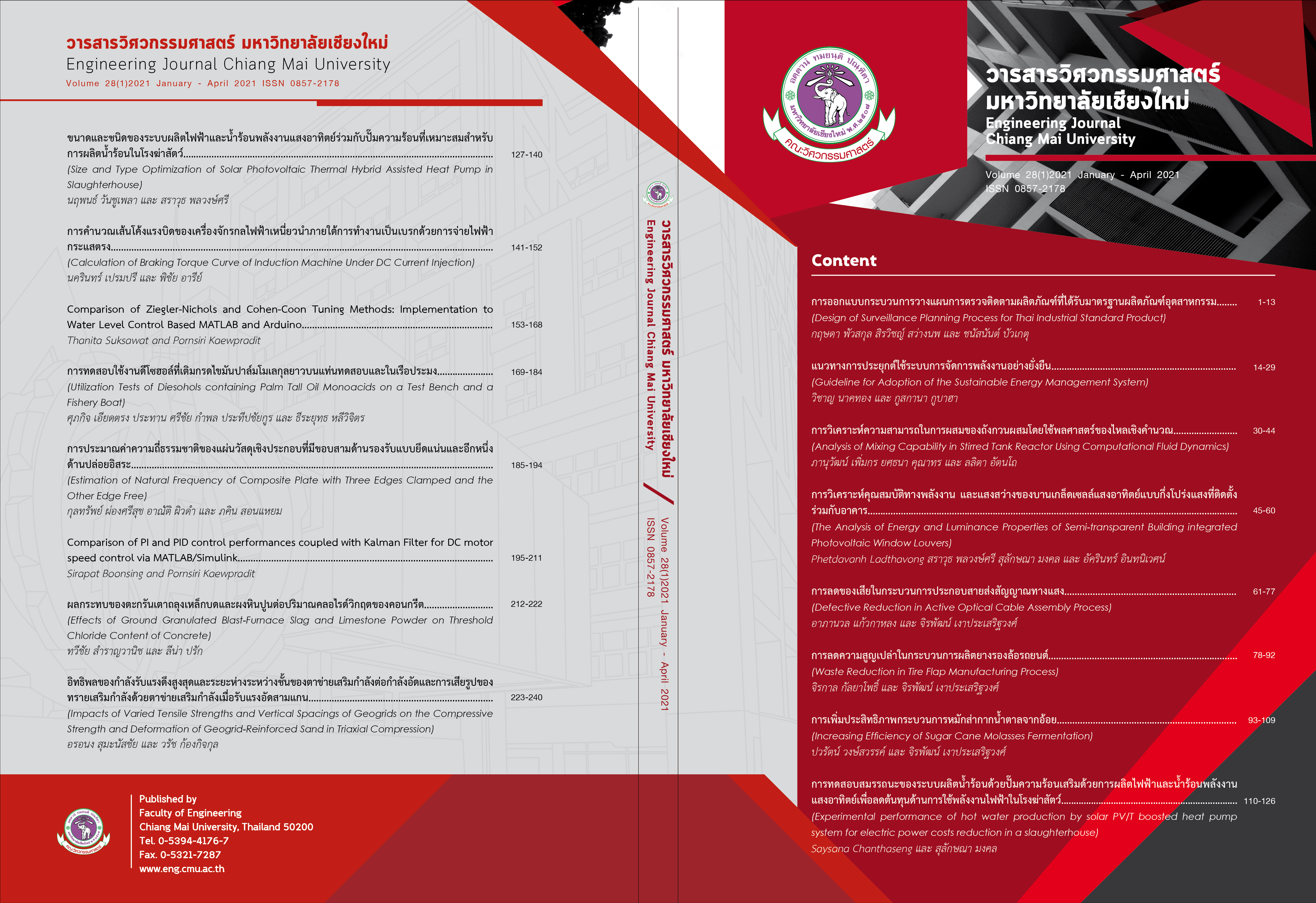The Analysis of Energy and Luminance Properties of Semi-transparent Building integrated Photovoltaic Window Louvers
Keywords:
Louvers, solar cells, Efficiency, Air ventilation, Heat transferAbstract
This work studies the production and utilization of PV window louvers with a building. Each louver contained 2 3 and 4 solar cells where a different cell number results in a different transparent and opaque area. The angle of the louver with respect to the horizontal was adjusted to be 0º (fully open) 18º (partially open) and 90º (fully closed). The comparison is made for each louver performance in terms of electrical properties, the ability to ventilate air as well as the luminance inside the building. It was found that the PV window louver conversion efficiency was in between 5-7%. The maximum electrical energy production of 0.3-0.356 kWh occurred when each louver contains 4 solar cells. The optimum louver angle for electrical energy production was found to be at 90º. It was seen that at the angle of 0º the heat can be ventilated at a maximum rate. It was demonstrated that the heat passing through (Qcover) and heat inside the building (Qi,room) was lowest when the louver was installed at 90°. The internal luminance was measured to be higher than 500 Lux, which is the standard luminance requirement for office building, for all louver angles.
References
I. E. Agency, Worldwide Trends in Energy Use and Efficiency. [Online] Available:http://www.envedu.gr/Documents/Worldwide%20Trends%20in%20Energy%20Use%20and%20Efficiency.pdf.
Pathways to 2050: Alternative Scenarios for Decarbonizing the U.S. Economy.[Online] Available: https://www.c2es.org/site/assets/uploads/2019/05/pathways-to-2050-scenarios-for-decarbonizing-the-us-economy-final.pdf
พลังงาน, กรุงเทพฯ: สมดุลพลังงาน เพื่อความยั่งยืนของเศรษฐกิจและสังคมไทย. บริษัท กรุงเทพธุรกิจ มีเดีย จ ากัด, 2013.
Zain-Ahmeda, A., Sopian, K., Othmanc, M.Y.H.,Sayighd, A.A.M. and Surendrand, P.N. Daylighting as a Passive Solar Design Strategy in Tropical Buildings: A Case Study of Malaysia. Energy Conversion and Management,2002; 43(13): 1725-1736,
Stegou-Sagia, K. A. A., Angelopoulou, C. and Kotsiovelos, G. The Impact of Glazing on Energy Consumption and Comfort. Energy Conversion and Management,2007;48(11): 2844-2852.
Bodart, A. D. H. M. Global Energy Savings in Offices Buildings by the Use of Daylighting. Energy and Buildings,2002; 34(5): 421-429.
Inanici, M.N. and Demirbilek, F.N. Thermal Performance Optimization of Building Aspect Ratio and South Window Size in Five Cities Having Different Climatic Characteristics ofTurkey. Building and Environment, 2000: 35(1): 41-52.
Wong Nyuk, W. L., Chandra, A.N., Pandey, A.R. and Xiaolin, W. Effects of Double Glazed Facade on Energy Consumption, Thermal Comfort and Condensation for a Typical Office Building in Singapore. Energy and Buildings,2005; 37(6): 563-572.
Alloca, Q.C.C., and Glickman, L.R. Design Analysis of Single-Sided Natural Ventilation. Energy and Buildings,2003;35: 785-795.
Changhai Peng, Y. H. and Wu, Z. Building-integrated Photovoltaics (BIPV) in Architectural Design in China. Energy and Buildings, 2011;43(12): 3592–3598.
Off-Grid Solar Power Basics. Samlexsolar, 2014. [Online] Avaible: https://samlexamerica.com/resources-support/faq/solarpowersystembasics/
Benefits of an Industrial Ventilation System 2015. [Online] Avaible: https://industrytoday.com/benefits-of-an-industrial-ventilation-system/.
การค านวณ (Air Changes) และมาตราฐาน ระบบระบายอากาศ. บริษัท เฟรช เอ็นเนอร์ยี่ เซฟวิ่ง จ ากัด, 2012. [ระบบออนไลน์] แหล่งที่มา: https://www.freshenergysaving.com
ภานุวิชญ์ พุทธรักษาและ สุลักษณามงคล.การพัฒนาระบบท าความเย็นแบบระเหยน ้าร่วมกับการบังคับทิศทางอากาศใต้รางปลูกสตอเบอรี่ในโรงเรือนเขตร้อน. สาขาวิศวกรรมพลังงานทดแทน,มหาวิทยาลัยแม่โจ้, 2018.
Majdoubi, H., Boulard, T., Hanafi, A., Bekkaoui, A., Fatnassi, H., Demrati, H., Nya, M. and Bouirden, L. Natural Ventilation Performance of a Large Greenhouse Equipped with Insect Screens. Transactions of the ASABE, 2007;50(2): 641-650.
Boulard, T. and Baille, A. Modelling of Air Exchange Rate in a Greenhouse Equipped with Continuous Roof Vents. Journal of Agricultural Engineering Research,1995; 61(1): 37-47.
Helenice Sacht, M. A. L. Windows Size and the Performance of Natural Ventilation. Procedia Engineering, , 2017; 196:972 –979.
Air Change Rates in typical Rooms and Buildings. Engineering Toolbox, 2011.
สุรินทร์ คันใจ และ สุลักษณา มงคล.การศึกษาการทาความเย็นแบบระเหยโดยตรงร่วมกับการลดความชื้นด้วยฮีทไปป์ส าหรับใช้ในบ้านพักอาศัย.สาขาวิชาวิศวกรรมพลังงานทดแทน มหาวิทยาลัยแม่โจ้,2559; 42-46.
ประกาศกระทรวงพลังงาน เรื่อง หลักเกณฑ์และวิธีการค านวณในการออกแบบอาคารแต่ละระบบ การใช้พลังงานโดยรวมของอาคาร และการใช้พลังงานหมุนเวียนในระบบต่าง ๆ ของอาคาร. กระทรวงพลังงาน, 2552.
Yumrutaş, R.,Kaşka, Ö. and Yıldırım, E. Estimation of Total Equivalent Temperature Difference Values for Multilayer Walls and Flat Roofs by Using Periodic Solution. Building and Environment, 2007; 42(5): 1878-1885.
CIE. International Commission on Illumination, 1913. [Online]Available: http://cie.co.at/
Downloads
Published
Issue
Section
License
ลิขสิทธิ์ของบทความที่ตีพิมพ์ในวารสารฉบับนี้จะยังเป็นของผู้แต่งและยินยอมให้สิทธิ์เผยแพร่กับทางวารสาร
การเผยแพร่ในระบบวารสารแบบเปิดนี้ บทความจะสามารถนำไปใช้ได้ฟรีในการศึกษา และในทางที่ไม่เกี่ยวกับการค้า




